Gas–Particle Partitioning and Temporal Dynamics of Pesticides in Urban Atmosphere Adjacent to Agriculture
Abstract
1. Introduction
2. Materials and Methods
2.1. Reagents and Chemicals
2.2. Sampling Procedure
2.3. Samples Extraction and Analysis
2.4. Quality Assurance/Quality Control (QA/QC)
2.5. Gas/Particle Partitioning
2.6. Inhalation Health Risk to Populations from Atmospheric Pesticides
3. Results and Discussions
3.1. Pesticide Detected in Air Samples
3.1.1. Detection Frequency by Pesticide Class
3.1.2. Most Detected in Gas Phase
3.1.3. Most Detected in Particle Phase
3.1.4. Gas–Particle Partitioning
3.1.5. Influence of Environmental Factors
3.2. Total Pesticide Load and Major Contributors
3.3. Seasonal Variability of Pesticide Concentrations
3.4. Comparison with Global Studies
4. Health Risk Exposure
5. Conclusions
Supplementary Materials
Author Contributions
Funding
Institutional Review Board Statement
Informed Consent Statement
Data Availability Statement
Conflicts of Interest
References
- Boonupara, T.; Udomkun, P.; Khan, E.; Kajitvichyanukul, P. Airborne pesticides from agricultural practices: A critical review of pathways, influencing factors, and human health implications. Toxics 2023, 11, 858. [Google Scholar] [CrossRef] [PubMed]
- Aktar, M.W.; Sengupta, D.; Chowdhury, A. Impact of pesticides use in agriculture: Their benefits and hazards. Interdiscip. Toxicol. 2009, 2, 1. [Google Scholar] [CrossRef] [PubMed]
- Lallas, P.L. The Stockholm Convention on persistent organic pollutants. Am. J. Int. Law 2001, 95, 692–708. [Google Scholar] [CrossRef]
- Udomkun, P.; Boonupara, T.; Sumitsawan, S.; Khan, E.; Pongpichan, S. and Kajitvichyanukul, P. Airborne pesticides—Deep diving into sampling and analysis. Toxics 2023, 11, 883. [Google Scholar] [CrossRef] [PubMed]
- Degrendele, C.; Okonski, K.; Melymuk, L.; Landlová, L.; Kukučka, P.; Audy, O.; Kohoutek, J.; Čupr, P.; Klánová, J. Pesticides in the atmosphere: A comparison of gas-particle partitioning and particle size distribution of legacy and current-use pesticides. Atmos. Chem. Phys. 2016, 16, 1531–1544. [Google Scholar] [CrossRef]
- Kamel, F. Paths from pesticides to Parkinson’s. Science 2013, 341, 722–723. [Google Scholar] [CrossRef] [PubMed]
- Mascarelli, A. Growing up with pesticides. Science 2013, 341, 740–741. [Google Scholar] [CrossRef] [PubMed]
- Parrón, T.; Requena, M.; Hernández, A.F.; Alarcón, R. Environmental exposure to pesticides and cancer risk in multiple human organ systems. Toxicol. Lett. 2014, 230, 157–165. [Google Scholar] [CrossRef] [PubMed]
- Yan, D.; Zhang, Y.; Liu, L.; Yan, H. Pesticide exposure and risk of Alzheimer’s disease: A systematic review and meta-analysis. Sci. Rep. 2016, 6, 32222. [Google Scholar] [CrossRef] [PubMed]
- DiBartolomeis, M.; Kegley, S.; Mineau, P.; Radford, R.; Klein, K. An assessment of acute insecticide toxicity loading (AITL) of chemical pesticides used on agricultural land in the United States. PLoS ONE 2019, 14, e0220029. [Google Scholar] [CrossRef] [PubMed]
- Goulson, D.; Thompson, J.; Croombs, A. Rapid rise in toxic load for bees revealed by analysis of pesticide use in Great Britain. PeerJ 2018, 6, e5255. [Google Scholar] [CrossRef] [PubMed]
- Kudsk, P.; Jørgensen, L.N.; Ørum, J.E. Pesticide load—A new Danish pesticide risk indicator with multiple applications. Land Use Policy 2018, 70, 384–393. [Google Scholar] [CrossRef]
- Degrendele, C.; Kanduč, T.; Kocman, D.; Lammel, G.; Cambelová, A.; Dos Santos, S.G.; Horvat, M.; Kukučka, P.; Šmejkalová, A.H.; Mikeš, O.; et al. NPAHs and OPAHs in the atmosphere of two central European cities: Seasonality, urban-to-background gradients, cancer risks and gas-to-particle partitioning. Sci. Total Environ. 2021, 793, 148528. [Google Scholar] [CrossRef] [PubMed]
- Fance3. Nombre D’exploitations, Surface, Types de Cultures: Les Chiffres Clés de L’agriculture en Alsace. 2019. Available online: https://france3-regions.francetvinfo.fr/grand-est/nombre-exploitations-surface-types-cultures-chiffres-cles-agriculture-alsace-1733597.html (accessed on 8 October 2019).
- Levy, M.; Al-Alam, J.; Delhomme, O.; Millet, M. An integrated extraction method coupling pressurized solvent extraction, solid phase extraction and solid-phase micro extraction for the quantification of selected organic pollutants in air by gas and liquid chromatography coupled to tandem mass spectrometry. Microchem. J. 2020, 157, 104889. [Google Scholar] [CrossRef]
- Yamasaki, H.; Kuwata, K.; Miyamoto, H. Effects of ambient temperature on aspects of airborne polycyclic aromatic hydrocarbons. Environ. Sci. Technol. 1982, 16, 189–194. [Google Scholar] [CrossRef]
- Murphy, R.R.; Haith, D.A. Inhalation health risk to golfers from turfgrass pesticides at three northeastern US sites. Environ. Sci. Technol. 2007, 41, 1038–1043. [Google Scholar] [CrossRef] [PubMed]
- U.S. EPA. Exposure Factors Handbook 2011 Edition (Final Report); U.S. Environmental Protection Agency: Washington, DC, USA, 2011; EPA/600/R-09/052F.
- PPDB. Pesticide Properties DataBase. 2023. Available online: https://sitem.herts.ac.uk/aeru/ppdb/ (accessed on 13 July 2025).
- FOCUS. Pesticides in Air: Considerations for Exposure Assessment; European Commission: Brussels, Belgium, 2008; p. 327, Report of the FOCUS Working Group on Pesticides in Air, EC Document Reference SANCO/10553/2006 Rev 2 June 2008.
- Khoury, D.; Jabali, Y.; Delhomme, O.; Millet, M. Pesticide occurrence and distribution in fogwater collected at four sites at Strasbourg metropolitan between 2015 and 2021. Environ. Pollut. 2024, 359, 124564. [Google Scholar] [CrossRef] [PubMed]
- Kruse-Plaß, M.; Hofmann, F.; Wosniok, W.; Schlechtriemen, U.; Kohlschütter, N. Pesticides and pesticide-related products in ambient air in Germany. Environ. Sci. Eur. 2021, 33, 144. [Google Scholar] [CrossRef]
- Zaller, J.G.; Kruse-Plaß, M.; Schlechtriemen, U.; Gruber, E.; Peer, M.; Nadeem, I.; Formayer, H.; Hutter, H.P.; Landler, L. Pesticides in ambient air, influenced by surrounding land use and weather, pose a potential threat to biodiversity and humans. Sci. Total Environ. 2022, 838, 156012. [Google Scholar] [CrossRef] [PubMed]
- Zhao, M.; Wu, J.; Figueiredo, D.M.; Zhang, Y.; Zou, Z.; Cao, Y.; Li, J.; Chen, X.; Shi, S.; Wei, Z.; et al. Spatial-temporal distribution and potential risk of pesticides in ambient air in the North China Plain. Environ. Int. 2023, 182, 108342. [Google Scholar] [CrossRef] [PubMed]
- Zhan, L.; Cheng, H.; Zhong, G.; Sun, Y.; Jiang, H.; Zhao, S.; Zhang, G.; Wang, Z. Occurrence of atmospheric current-use and historic-use pesticides at a CAWNET background site in central China. Sci. Total Environ. 2021, 775, 145802. [Google Scholar] [CrossRef]
- Schummer, C.; Mothiron, E.; Appenzeller, B.M.; Rizet, A.L.; Wennig, R.; Millet, M. Temporal variations of concentrations of currently used pesticides in the atmosphere of Strasbourg, France. Environ. Pollut. 2010, 158, 576–584. [Google Scholar] [CrossRef] [PubMed]
- Foreman, W.T.; Majewski, M.S.; Goolsby, D.A.; Wiebe, F.W.; Coupe, R.H. Pesticides in the atmosphere of the Mississippi River Valley, part II—Air. Sci. Total Environ. 2000, 248, 213–226. [Google Scholar] [CrossRef] [PubMed]
- Habran, S.; Giusti, A.; Galloy, A.; Gérard, G.; Delvaux, A.; Pigeon, O.; Remy, S. Spatial and temporal variations of currently used pesticides (CUPs) concentrations in ambient air in Wallonia, Belgium. Chemosphere 2024, 351, 141241. [Google Scholar] [CrossRef] [PubMed]
- Van Dijk, H.F.G.; Van Pul, W.A.J.; De Voogt, P. Fate of Pesticides in the Atmosphere; Kluwer Academic Publishers: Dordrecht, The Netherlands, 1999; ISBN 0-7923-59941-1. [Google Scholar]
- Coscollà, C.; Hart, E.; Pastor, A.; Yusà, V. LC-MS characterization of contemporary pesticides in PM10 of Valencia Region, Spain. Atmos. Environ. 2013, 77, 394–403. [Google Scholar] [CrossRef]
- Zhang, L.; Huang, Y.; Dong, L.; Shi, S.; Zhou, L.; Zhang, T.; Mi, F.; Zeng, L.; Shao, D. Levels, seasonal patterns, and potential sources of organochlorine pesticides in the urban atmosphere of Beijing, China. Arch. Environ. Contam. Toxicol. 2011, 61, 159–165. [Google Scholar] [CrossRef] [PubMed]
- The New Lede. Pesticides found in 80% of Air Samples from California Farm Communities. 2024. Available online: https://www.thenewlede.org/2024/10/pesticides-found-in-80-of-air-samples-from-california-farm-communities/ (accessed on 1 October 2024).
- Ni, J.; Cai, M.; Lin, Y.; Li, T.; Ma, J. Occurrence, seasonal variations, and spatial distributions of current-use organoamine pesticides in the atmosphere of Shanghai, China. Atmos. Pollut. Res. 2024, 15, 102187. [Google Scholar] [CrossRef]
- Zhang, X.; Zhang, X.; Zhang, Z.F.; Yang, P.F.; Li, Y.F.; Cai, M.; Kallenborn, R. Pesticides in the atmosphere and seawater in a transect study from the Western Pacific to the Southern Ocean: The importance of continental discharges and air-seawater exchange. Water Res. 2022, 217, 118439. [Google Scholar] [CrossRef] [PubMed]
- Atmo Grand Est. Évaluation des Pesticides en Grand Est—Rapport Final 2021; ATMO Grand Est: Schiltigheim, France, 2021. [Google Scholar]
- Lopez, A.; Yusà, V.; Munoz, A.; Vera, T.; Borras, E.; Ródenas, M.; Coscolla, C. Risk assessment of airborne pesticides in a Mediterranean region of Spain. Sci. Total Environ. 2017, 574, 724–734. [Google Scholar] [CrossRef] [PubMed]
- Hu, Y.; Wu, S.; Lyu, W.; Ning, J.; She, D. Risk assessment of human exposure to airborne pesticides in rural greenhouses. Sci. Rep. 2023, 13, 5138. [Google Scholar] [CrossRef] [PubMed]
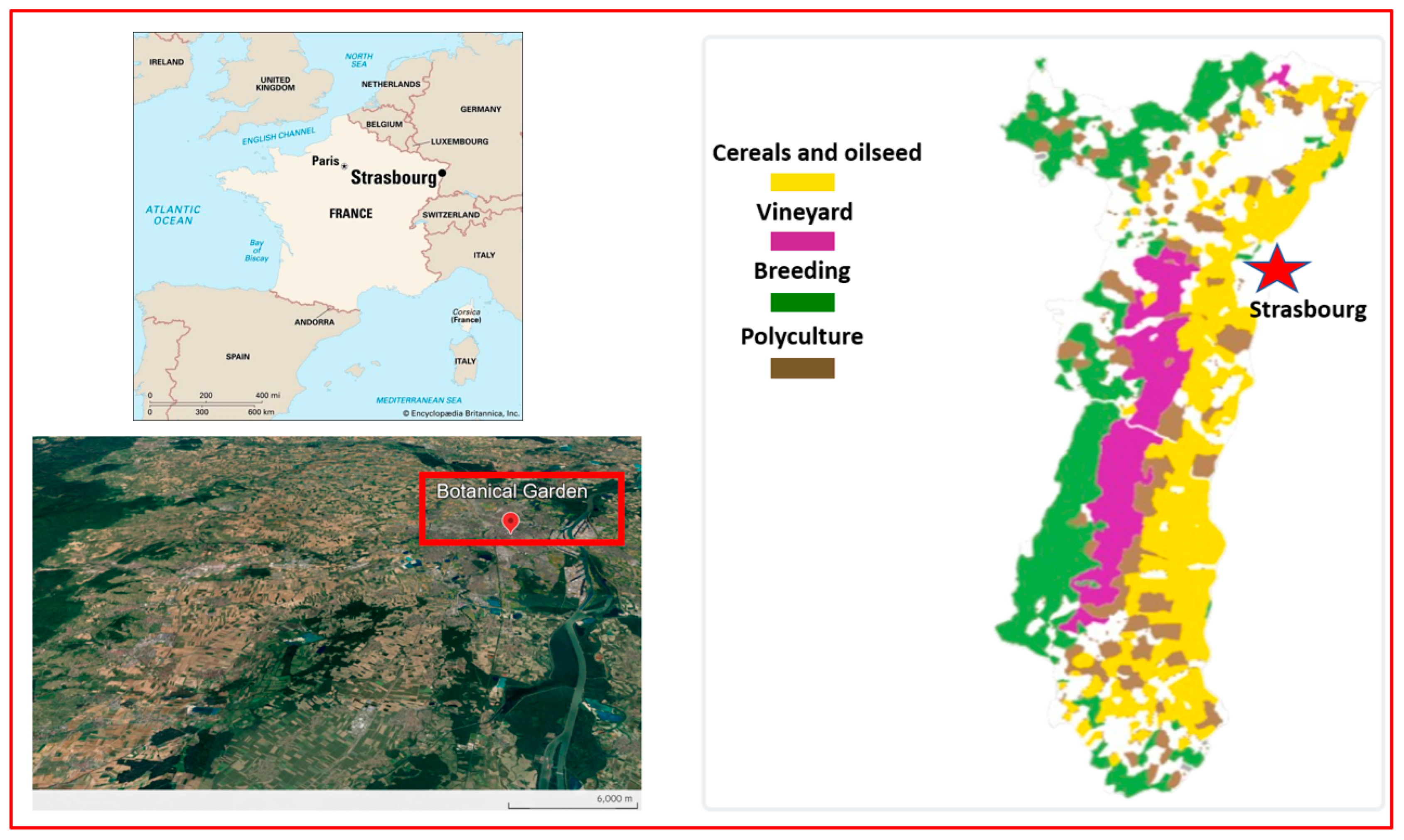
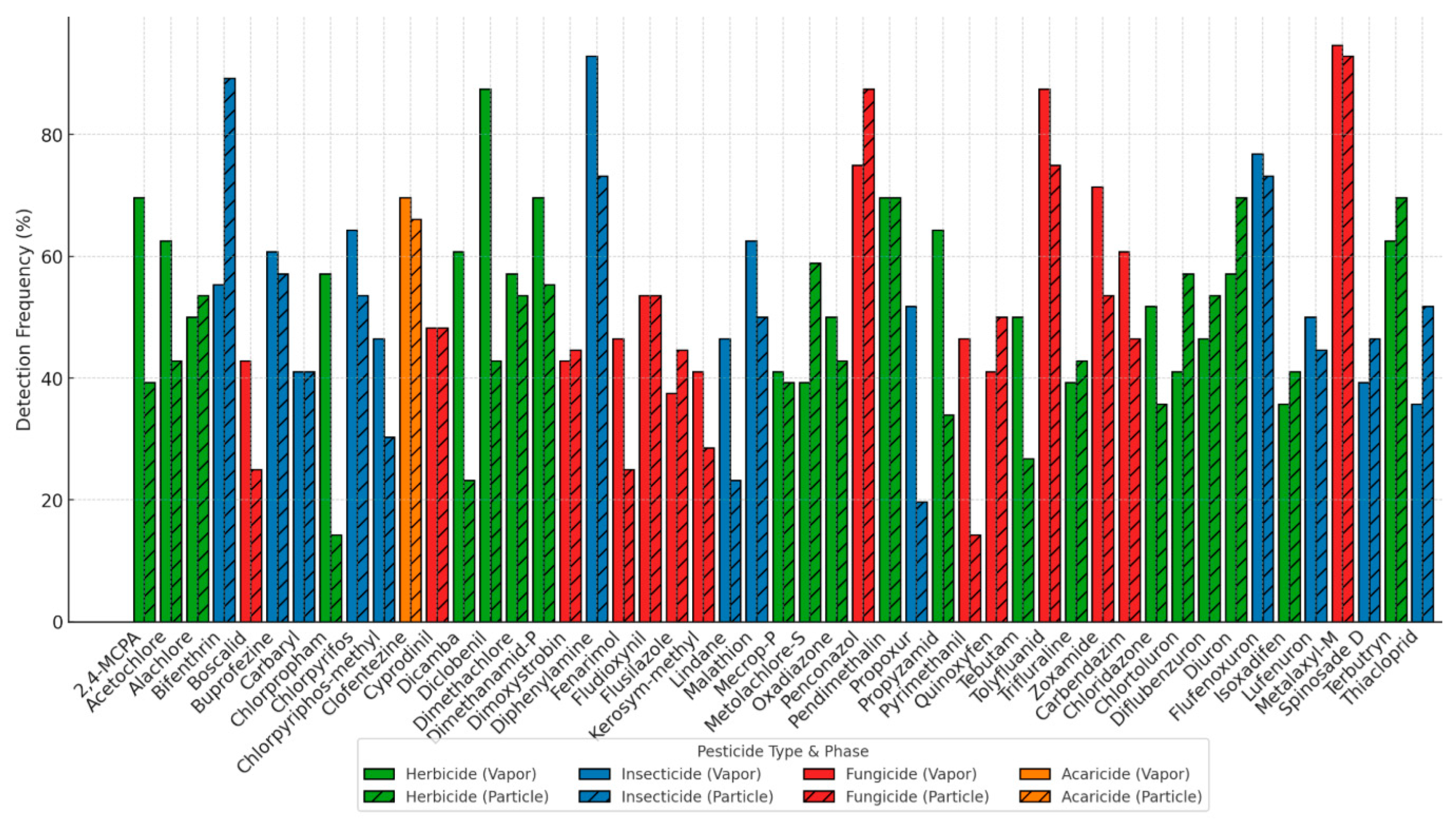

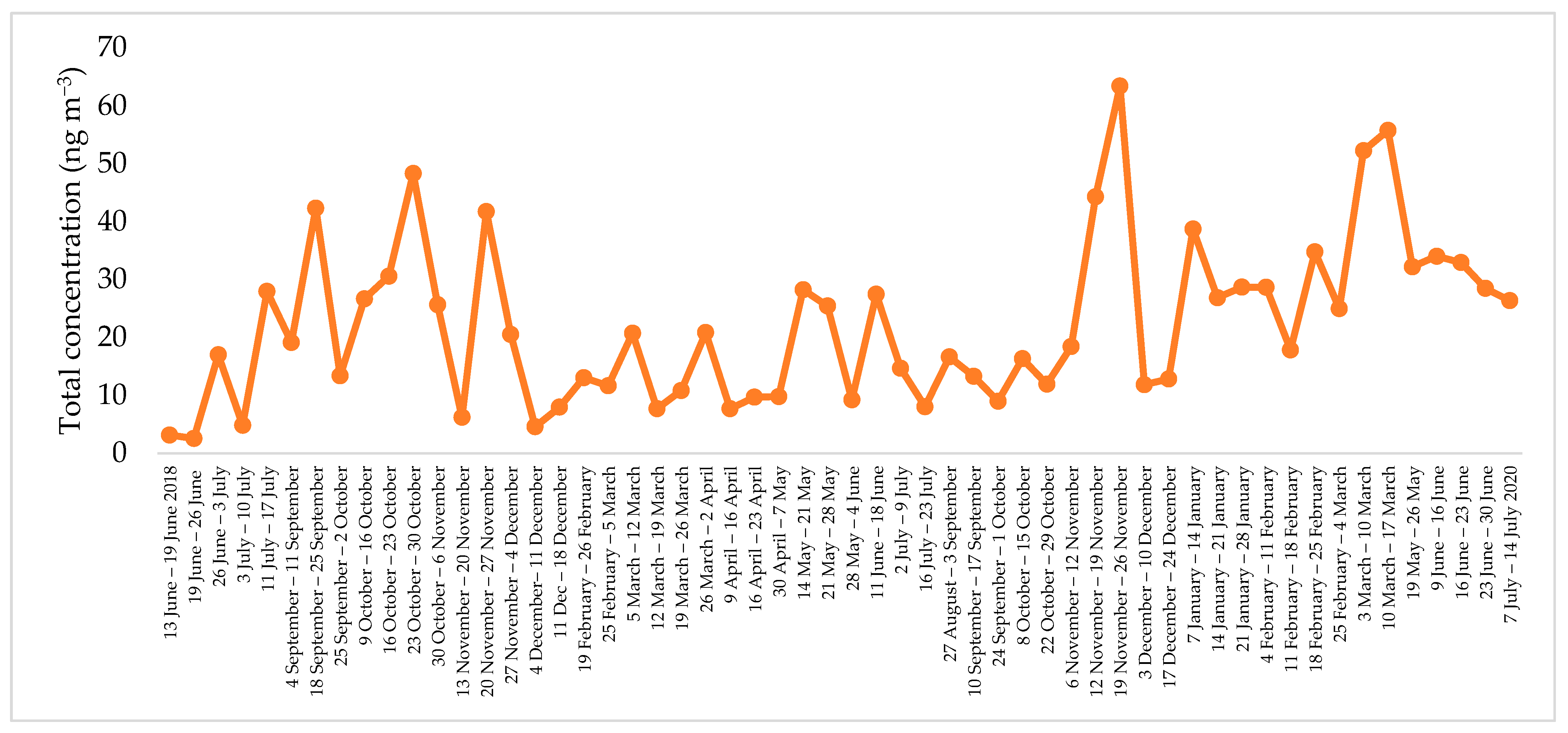
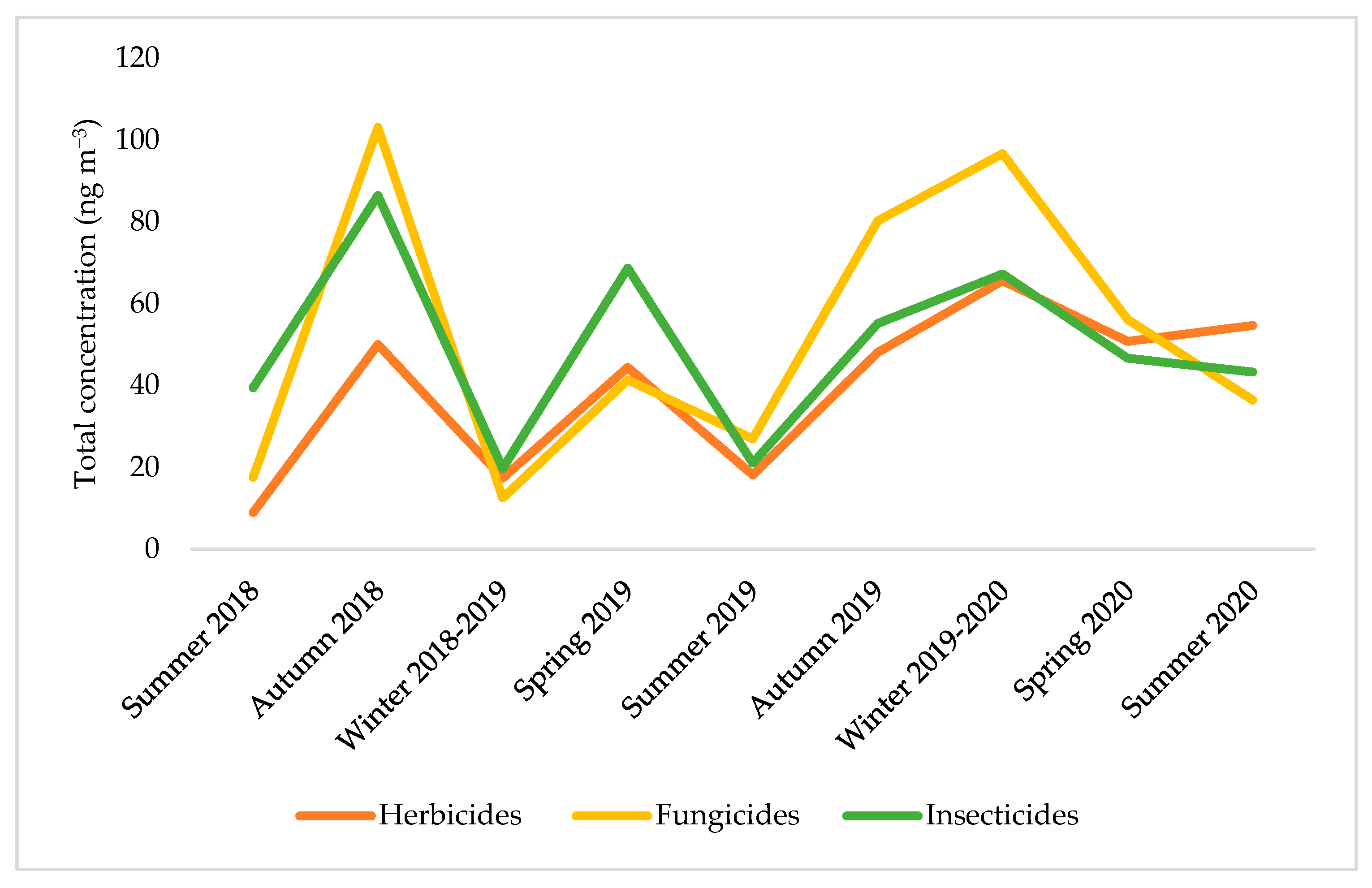
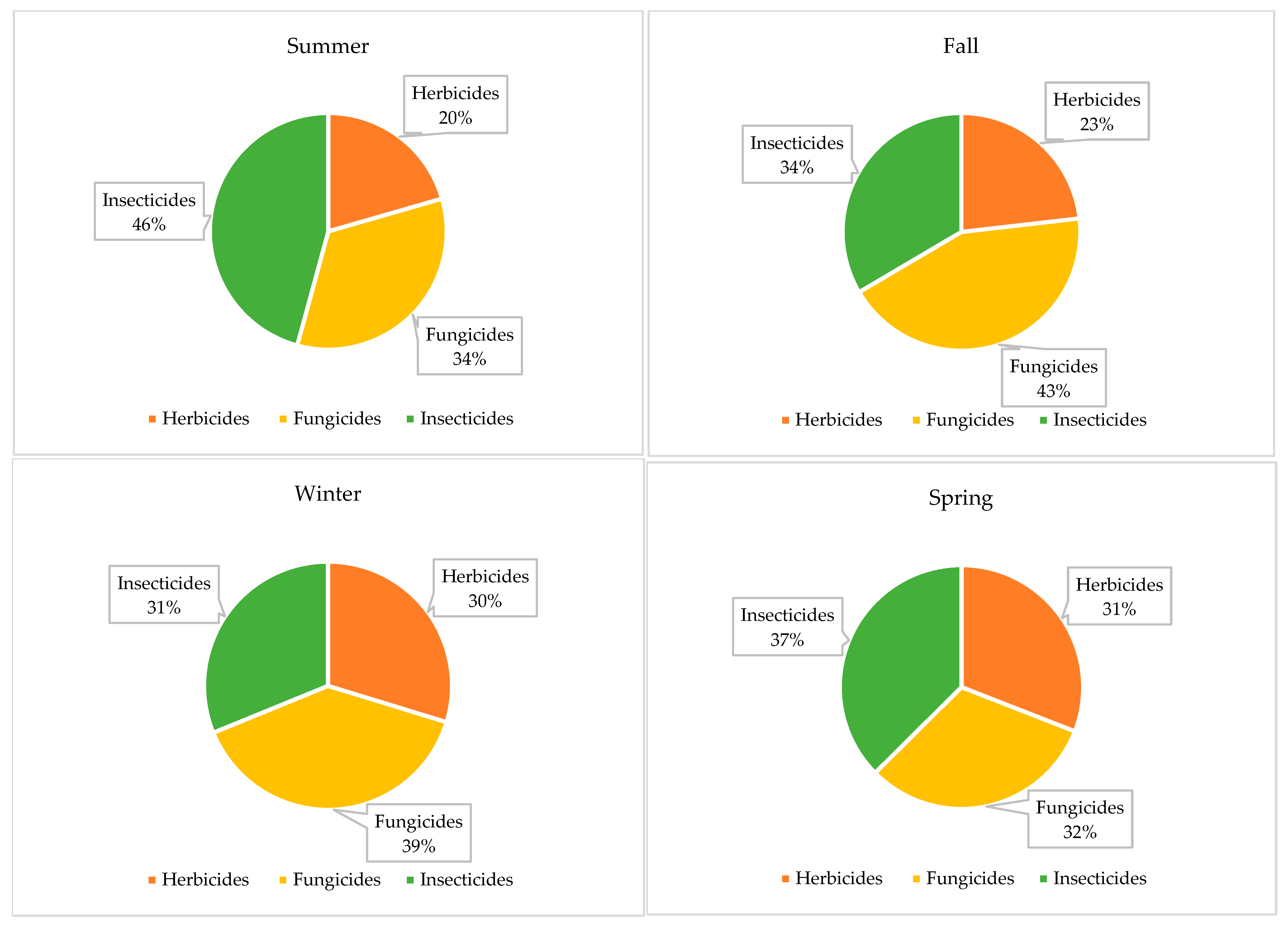
| Parameter | GC-MS/MS (Semi-Volatile Pesticides) | LC-MS/MS (Non-Volatile Pesticides) |
|---|---|---|
| Instrument | Thermo Scientific Trace Ultra/ITQ 700 + QQQ MS/MS | Thermo Scientific Surveyor + TSQ Quantum Access Max QQQ MS/MS |
| Pre-concentration | SPME (Polyacrylate fiber (85 µm) at 60 °C for 40 min). | Direct Injection |
| Mode | MRM (Multiple Reaction Monitoring) | |
| Column | Optima XLB (30 m L × 0.25 mm i.d × 0.25 µm film) | Nucleodur C18 Pyramid (150 mm L × 3 mm i.d × 3 µm particle diameter) |
| Column Temperature | Oven: Programmed | Thermostated at 25 °C |
| Injection Mode | Splitless at 250 °C for 15 min | |
| Transfer Line Temperature | 300 °C | 300 °C |
| Ion Source Temp | 210 °C | 30 °C |
| Carrier Gas/Flow Rate | Helium at 1 mL min−1 | ACN (B)/Water (A)+ 0.1% formic acid at 0.3 mL min−1 |
| Ionization Mode | Electron Impact (EI) | Positive Electrospray Ionization (ESI+) |
| Oven Temperature Program | 50 °C (3 min) → 160 °C @ 36.6 °C min−1 → 300 °C @ 5.8 °C min−1 (10 min hold) | 30(B):70(A) (5 min) → 50(B):50(A) (6 min) → 80(B):20(A) (7 min) → 95(B):5(A) (10 min) → 30(B):70(A) (8 min) |
| Variable | PC | Correlation (r) | p-Value | Significance |
|---|---|---|---|---|
| Temperature | PC1 | 0.190 | 0.22113 | Not significant |
| Temperature | PC2 | −0.804 | <0.00001 | Highly significant |
| Rainfall | PC1 | 0.819 | <0.00001 | Highly significant |
| Rainfall | PC2 | 0.270 | 0.07989 | Marginal |
| TSP | PC1 | −0.820 | <0.00001 | Highly significant |
| TSP | PC2 | −0.177 | 0.25658 | Not significant |
| Particle-phase | PC1 | −0.558 | 0.01842 | Significant |
| Particle-phase | PC2 | −0.120 | 0.44530 | Not significant |
| Gas-phase | PC1 | −0.360 | 0.01783 | Significant |
| Gas-phase | PC2 | 0.711 | <0.00001 | Highly significant |
Disclaimer/Publisher’s Note: The statements, opinions and data contained in all publications are solely those of the individual author(s) and contributor(s) and not of MDPI and/or the editor(s). MDPI and/or the editor(s) disclaim responsibility for any injury to people or property resulting from any ideas, methods, instructions or products referred to in the content. |
© 2025 by the authors. Licensee MDPI, Basel, Switzerland. This article is an open access article distributed under the terms and conditions of the Creative Commons Attribution (CC BY) license (https://creativecommons.org/licenses/by/4.0/).
Share and Cite
Khoury, D.; Chimjarn, S.; Delhomme, O.; Millet, M. Gas–Particle Partitioning and Temporal Dynamics of Pesticides in Urban Atmosphere Adjacent to Agriculture. Atmosphere 2025, 16, 873. https://doi.org/10.3390/atmos16070873
Khoury D, Chimjarn S, Delhomme O, Millet M. Gas–Particle Partitioning and Temporal Dynamics of Pesticides in Urban Atmosphere Adjacent to Agriculture. Atmosphere. 2025; 16(7):873. https://doi.org/10.3390/atmos16070873
Chicago/Turabian StyleKhoury, Dani, Supansa Chimjarn, Olivier Delhomme, and Maurice Millet. 2025. "Gas–Particle Partitioning and Temporal Dynamics of Pesticides in Urban Atmosphere Adjacent to Agriculture" Atmosphere 16, no. 7: 873. https://doi.org/10.3390/atmos16070873
APA StyleKhoury, D., Chimjarn, S., Delhomme, O., & Millet, M. (2025). Gas–Particle Partitioning and Temporal Dynamics of Pesticides in Urban Atmosphere Adjacent to Agriculture. Atmosphere, 16(7), 873. https://doi.org/10.3390/atmos16070873









